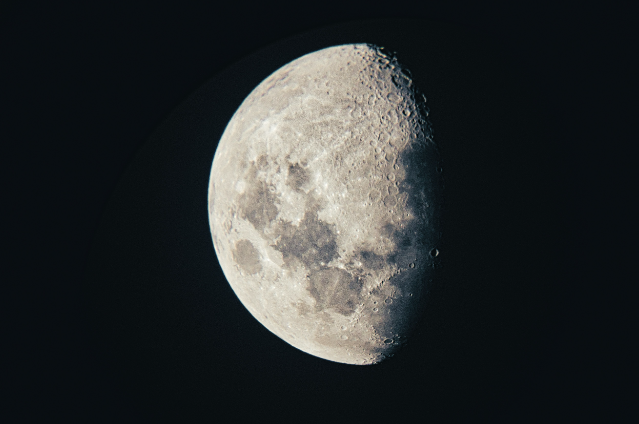
Photo by Erwan Hesry on Unsplash
The dark side of the moon, often shrouded in mystery and myth, sparks the curiosity of many. While the term is a misnomer—both sides of the moon receive sunlight—let's delve into a hypothetical scenario where unique forms of life thrive in the permanently shadowed regions. This exploration combines scientific speculation, creative imagination, and a touch of humor to envision an extraordinary ecosystem.
Environment
The landscape of the dark side of the moon is rugged, characterized by deep craters, jagged mountains, and vast plains covered in ice. The temperature here is brutally cold, plunging to around -250 degrees Fahrenheit. Despite the harsh conditions, life finds a way to adapt and flourish in this stark environment.
Geological Features:
The craters are remnants of ancient asteroid impacts, now serving as natural shelters for various forms of life.
The mountains, though desolate and rocky, provide a stunning backdrop against the inky black sky, creating an otherworldly beauty.
The Sky:
The sky is perpetually dark, adorned with a breathtaking view of distant stars. Occasionally, Earthlight illuminates the landscape, casting a soft, ethereal glow.
The absence of atmosphere means no twinkling stars, giving the sky a serene and static appearance.
Flora:
In this alien world, bioluminescence is key to survival. Plants here have evolved to emit their own light, creating a mesmerizing, dreamlike forest that glows in hues of blue, green, and purple.
Luminous Trees:
Towering bioluminescent trees dominate the landscape. Their leaves absorb faint ambient light and emit a gentle glow, guiding nocturnal creatures through the forest.
These trees have deep roots that tap into subterranean ice for water, and their leaves can convert the minimal sunlight they receive into energy through a unique form of photosynthesis.
Icy Fungi:
Fungi-like organisms thrive in the icy soil, breaking down minerals and releasing essential nutrients. They too emit a soft light, creating an underground network of glowing threads.
These fungi are essential for recycling organic matter and maintaining soil fertility.
Fauna:
Life on the dark side of the moon has evolved in fascinating ways to cope with extreme cold and perpetual darkness.
Insect-like Creatures:
Small, hardy creatures with exoskeletons designed to withstand the cold scuttle about. Their exoskeletons are covered in tiny, reflective scales that glitter in the bioluminescent light, giving them a jewel-like appearance.
These insects can jump great distances and glide through the thin atmosphere, moving with surprising grace.
Warm-blooded Mammals:
Small mammals with thick fur and large, luminous eyes adapted to low light levels inhabit the craters. They burrow into the ground to stay warm and emerge at night to forage.
These creatures are social and live in tight-knit family groups, relying on each other for warmth and protection.
Amphibious Beings:
Near the few liquid water sources, amphibious beings with bioluminescent skin can be found. They use their glow to communicate and attract mates, creating stunning displays of light during mating rituals.
These creatures have webbed feet and hands, allowing them to swim gracefully in the icy waters.
Intelligent Life
Let's imagine a highly advanced alien civilization thriving in this challenging environment. These beings have developed remarkable technology to harness the moon's limited resources.
Habitat:
Dome-like structures built into the craters provide insulation and protection from cosmic radiation. These habitats blend seamlessly with the landscape, designed to minimize environmental impact.
Inside, the temperature is controlled, and the air is rich in oxygen, creating a comfortable living space.
Technology:
Geothermal energy is harnessed to provide heat and power. The aliens have also developed advanced ice-harvesting techniques to extract water.
Solar panels are placed on the few sunlit areas, capturing energy to be stored and used during the long periods of darkness.
Society and Culture:
This civilization is nocturnal, with a deep connection to the rhythms of their environment. They value harmony and sustainability, living in tune with the natural cycles of the moon.
Art and culture are heavily influenced by the cosmos. Storytelling, music, and dance often center around celestial events and the mysteries of the universe.
Interesting Facts and Humorous Tidbits
Gravity:
The moon's gravity is only about one-sixth that of Earth's. This makes for some entertaining spectacles, like creatures bounding effortlessly across the landscape and performing gravity-defying acrobatics.
Imagine a game of lunar basketball, where players can dunk with ease and the ball seems to float in slow motion!
Cuisine:
The alien cuisine is a delightful fusion of bioluminescent plants and fungi, creating dishes that glow in the dark. Picture a salad that lights up your plate or a soup that shimmers with every stir.
For dessert, there's always moon-ice cream, made from the finest lunar ice and topped with glowing fruit syrup.
Communication:
The beings communicate using bioluminescent signals, creating beautiful displays of light that convey complex messages. It's like watching a conversation in Morse code, but far more mesmerizing.
Misunderstandings can be quite amusing, especially when someone accidentally says "hello" in a way that looks like "your antennae are crooked."
Conclusion
Imagining life on the dark side of the moon offers a blend of scientific curiosity and whimsical creativity. Though the conditions are harsh, life has adapted in extraordinary ways, creating a unique and vibrant ecosystem. From bioluminescent forests to gravity-defying creatures and advanced alien civilizations, this scenario paints a captivating picture of what could be. While it remains a flight of fancy, it reminds us of the boundless possibilities that lie beyond our world and the wonders that imagination can bring to life.
